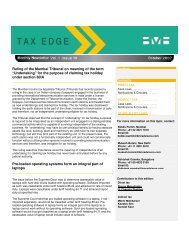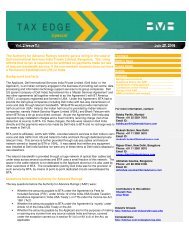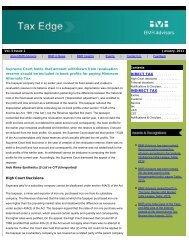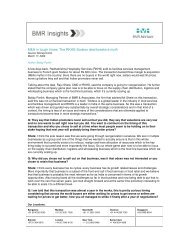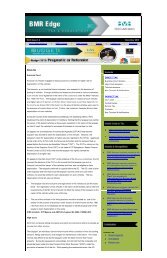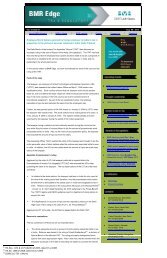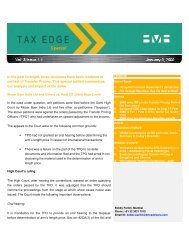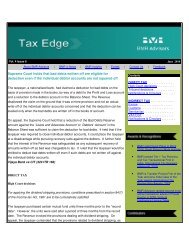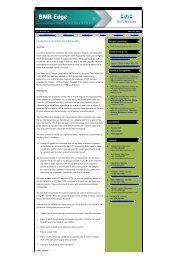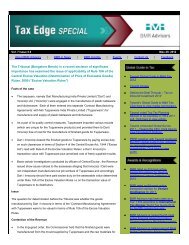Corporate Tax 2010 - BMR Advisors
Corporate Tax 2010 - BMR Advisors
Corporate Tax 2010 - BMR Advisors
Create successful ePaper yourself
Turn your PDF publications into a flip-book with our unique Google optimized e-Paper software.
BC Toms & Co<br />
Ukraine<br />
pricing rules may also apply to transactions between foreign<br />
companies and their branches in Ukraine.<br />
Such rules are applied, to begin with, by presuming that the stated<br />
contract price is an arm’s length price, but this presumption may be<br />
challenged by the tax authorities. The principal method used for<br />
determining arm’s length prices is, with certain exceptions, the<br />
Comparable Uncontrolled Price method pursuant to which the tax<br />
authorities may adjust the price of transactions between related<br />
parties to the “usual price” for profits tax purposes. The usual price<br />
is essentially the market price for equivalent transactions where the<br />
goods or services are sold to independent persons under usual<br />
economic conditions. If where these rules apply, the contract price<br />
is higher than the usual price at the time of the purchase, however,<br />
the usual price should be applied for tax purposes.<br />
For natural monopolists, the arm’s length price may be established<br />
by the Resale Price method or, in certain cases, by the Cost Plus<br />
method, under regulations to be promulgated by the Cabinet of<br />
Ministers of Ukraine.<br />
4 <strong>Tax</strong> on Business Operations: General<br />
4.1 What is the headline rate of tax on corporate profits<br />
The standard corporate profits tax rate is 25 per cent. This rate<br />
applies to the taxable income of Ukrainian companies and the<br />
permanent establishments in Ukraine of foreign companies. As an<br />
exception, the income of resident insurance companies, defined as<br />
the amount of insurance and reinsurance premiums received by<br />
such companies reduced by the amounts of any insurance premiums<br />
payable by such companies to residents for reinsurance, is taxed at<br />
either a 0 or a 3 per cent. tax rate, depending on the type of<br />
insurance involved.<br />
Certain legal entities may opt to use the simplified taxation system<br />
according to which VAT registered entities pay tax at a rate of 6 per<br />
cent. of their sales proceeds, and non-VAT registered entities pay at<br />
a rate of 10 per cent. There is also a minimal tax under a simplified<br />
taxation method provided for private entrepreneurs with relatively<br />
small turnover.<br />
In addition, some types of income (such as dividends, interest,<br />
royalties, lease payments, income from the disposition of real estate<br />
located in Ukraine, income from transactions with securities or<br />
other corporate rights, broker fees, agent fees and several other<br />
types of Ukrainian source income) paid by Ukrainian residents or<br />
Ukrainian permanent establishments of non-residents to nonresident<br />
companies are subject to a 15 per cent. final withholding<br />
tax. Reduced tax rates (or a tax relief) may apply based on tax<br />
treaties entered by Ukraine and special rules apply if the recipient is<br />
a company having a permanent establishment in Ukraine.<br />
4.3 What is the tax base for that tax (profits pursuant to<br />
commercial accounts subject to adjustments; other tax<br />
base)<br />
The calculation of the tax base for corporate profits tax is not based<br />
on financial accounting standards. Instead, the taxable income for<br />
corporate profits tax purposes is solely determined, following<br />
Ukrainian tax accounting rules, by deducting from the adjusted<br />
gross income any allowable gross expenses and depreciation<br />
deductions. The adjusted gross income includes all revenues from<br />
all types of activities received or accrued by a taxpayer during the<br />
relevant tax accounting period, both from Ukrainian and foreign<br />
sources. The tax base for insurance companies is determined<br />
following special rules, as indicated above.<br />
4.4 If it otherwise differs from the profit shown in commercial<br />
accounts, what are the main other differences<br />
Generally, taxable income differs significantly from the profits<br />
shown in commercial accounts. This is mostly due to the<br />
exemptions for certain types of income from being considered as<br />
taxable income, the existence of severe restrictions on the<br />
deductibility of certain expenses for tax purposes and the<br />
application of different depreciation methods under tax accounting<br />
rules as compared to financial accounting standards.<br />
4.5 Are there any tax grouping rules Do these allow for relief<br />
in Ukraine for losses of overseas subsidiaries<br />
There is no system for group taxation in Ukraine, and therefore the<br />
members of a corporate group must file separate tax returns. There<br />
are no provisions under Ukrainian law that would allow the losses<br />
of one group member to be applied to reduce the profits of another<br />
group member.<br />
Under the general rules, if a Ukrainian company has a branch<br />
(which is not a separate legal entity) located in a regional or<br />
municipal jurisdiction different from that where the company itself<br />
is principally registered, such branch should also be separately<br />
registered as a payer of corporate profits tax. The company,<br />
however, may decide to file a consolidated tax return, in which case<br />
the amount of corporate profits tax payable respectively at the<br />
principal location of the company and at the location of each branch<br />
are allocated following a set procedure.<br />
4.6 Is tax imposed at a different rate upon distributed, as<br />
opposed to retained, profits<br />
The same corporate profit tax rate (25 per cent.) applies both to<br />
distributed and retained profits.<br />
Ukraine<br />
4.2 When is that tax generally payable<br />
Under the generally applicable rules, the corporate profits tax must<br />
be assessed and reported for each of the first three quarterly fiscal<br />
periods, including for the fiscal year through each such quarter and<br />
for the full fiscal year reporting period, within 40 days after the end<br />
of each such period. The tax should be paid quarterly, within 10<br />
calendar days after each tax declaration for a reporting period must<br />
be filed, so that the tax must be paid within 50 calendar days after<br />
the end of each of the first three quarterly reporting periods and<br />
after the end of the fiscal year. A fiscal tax year is a calendar year.<br />
Withholding taxes should be paid not later than the date that the<br />
income is paid.<br />
ICLG TO: CORPORATE TAX <strong>2010</strong><br />
© Published and reproduced with kind permission by Global Legal Group Ltd, London<br />
4.7 What other national taxes (excluding those dealt with in<br />
“Transaction <strong>Tax</strong>es”, above) are there - e.g. property taxes,<br />
etc.<br />
The most significant national taxes and duties not discussed above<br />
include individual income tax, land tax, rental payments and other<br />
fees on oil and gas, tax on the owners of motor vehicles and the<br />
mandatory payments to the State pension fund.<br />
4.8 Are there any local taxes not dealt with in answers to<br />
other questions<br />
The principal local taxes and fees include the advertising tax,<br />
255<br />
WWW.ICLG.CO.UK







